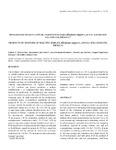
Please use this identifier to cite or link to this item:
http://ricaxcan.uaz.edu.mx/jspui/handle/20.500.11845/935| Title: | Sistemas de Producción de Cebada Maltera altera (Hordeum vulgare L.) en el Estado stado de Zacatecas acatecas , MÉXICO |
| Other Titles: | Production systems of malting malting barley (Hordeum vulgare L.) in Zacatecas acatecas state statestate , Mexico |
| Authors: | Álvarez Díaz, Paulino Luna Flores, Maximino Hernández Martínez, José Lara Herrera, Alfredo Salas Luevano, Miguel Ángel Cabañas Cruz, Bertoldo |
| Issue Date: | May-2006 |
| Publisher: | Instituto Nacional de Investigaciones Forestales, Agrícolas y Pecuarias |
| Abstract: | Con el objetivo de caracterizar los sistemas de producción de cebada maltera en el estado de Zacatecas, México, en el año 2004 se entrevistó a una muestra aleatoria de 48 productores de este cereal. Se aplicó un cuestionario diseñado con base en la Metodología de Evaluación de Cadenas Agro-alimenticias. Se registró información de 194 variables que fueron sometidas a análisis multifactorial y de conglomerados para delimitar los sistemas de producción. Se identificaron tres sistemas, cuyas características principales para el Sistema I fueron: Cincuenta años de edad promedio de los productores, escolaridad menor a secundaria, superficies de tierra propia de 43 ha y 81 ha sembradas, baja disponibilidad de riego, método de siembra al voleo sin corrugaciones, rendimiento medio de 1.6 t ha-1, de 10 a 30% de grano no apto para malta, relación beneficio/costo de 1.7. En el Sistema II fueron: Promedio de 40 años de edad de los productores, educación secundaria-bachillerato, 50 ha propias y 82 ha sembradas, siembra al voleo sin corrugaciones y rendimiento entre 1.5-2.5 t ha-1, 10% de grano no apto para malta, relación beneficio/costo de 1.7. El Sistema III tuvo: Edad promedio de 36 años, escolaridad de bachillerato, superficie propia de 215 ha y superficie sembrada de 245 ha, método de siembra de precisión, rendimiento de 1.8 t ha-1, 5% de grano no apto para malta, relación beneficio/costo de 1.45. La productividad de los sistemas se relacionó directamente con la escolaridad de los productores y el método de siembra e inversamente con la edad. |
| Description: | In order to know the production systems of malting barley in the state of Zacatecas, a diagnosis study was carried out by direct interview to 48 farmers following a questionnaire based on the evaluation of market chains. Data was gathered on 194 variables and submitted to multifactorial and cluster analysis. Three production system were defined whose main characteristics for System I were: 50 years average age, education up to elementary school, 43 ha of land property and cultivation of 81 ha, low irrigation availability, method of sowing without rows and soil corrugationsm, average yield, 1.6 t ha-1, 10-30% of grain not suitable for malting, profit/cost ratio, 1.7. For System II: 40 years average age, education up to high school, 50 ha of land property and cultivation of 82 ha, method of sowing without rows and soil corrugations, yield from 1.5 to 2.5 t ha-1, 10% of grain not suitable for malting, profit/cost ratio, 1.7. For System III: 36 years average age, education up to baccalaureate, 215 ha of land property and cultivation of 250 ha, precision sowing average yield, 1.8 t ha-1, 5% of grain not suitable for malting, profit/cost ratio, 1.45. The productivity of the systems was directly related to farmer’s level of education, and the sowing method used, and inversely related with farmer’s age. |
| URI: | http://ricaxcan.uaz.edu.mx/jspui/handle/20.500.11845/935 https://doi.org/10.48779/8zh1-md34 |
| ISSN: | 0568-2517 |
| Other Identifiers: | info:eu-repo/semantics/publishedVersion |
| Appears in Collections: | *Documentos Académicos*-- UA de Agronomía |
Files in This Item:
| File | Description | Size | Format | |
|---|---|---|---|---|
| Sistemas de producción de cebada maltera.pdf | 677,18 kB | Adobe PDF |  View/Open |
This item is licensed under a Creative Commons License
